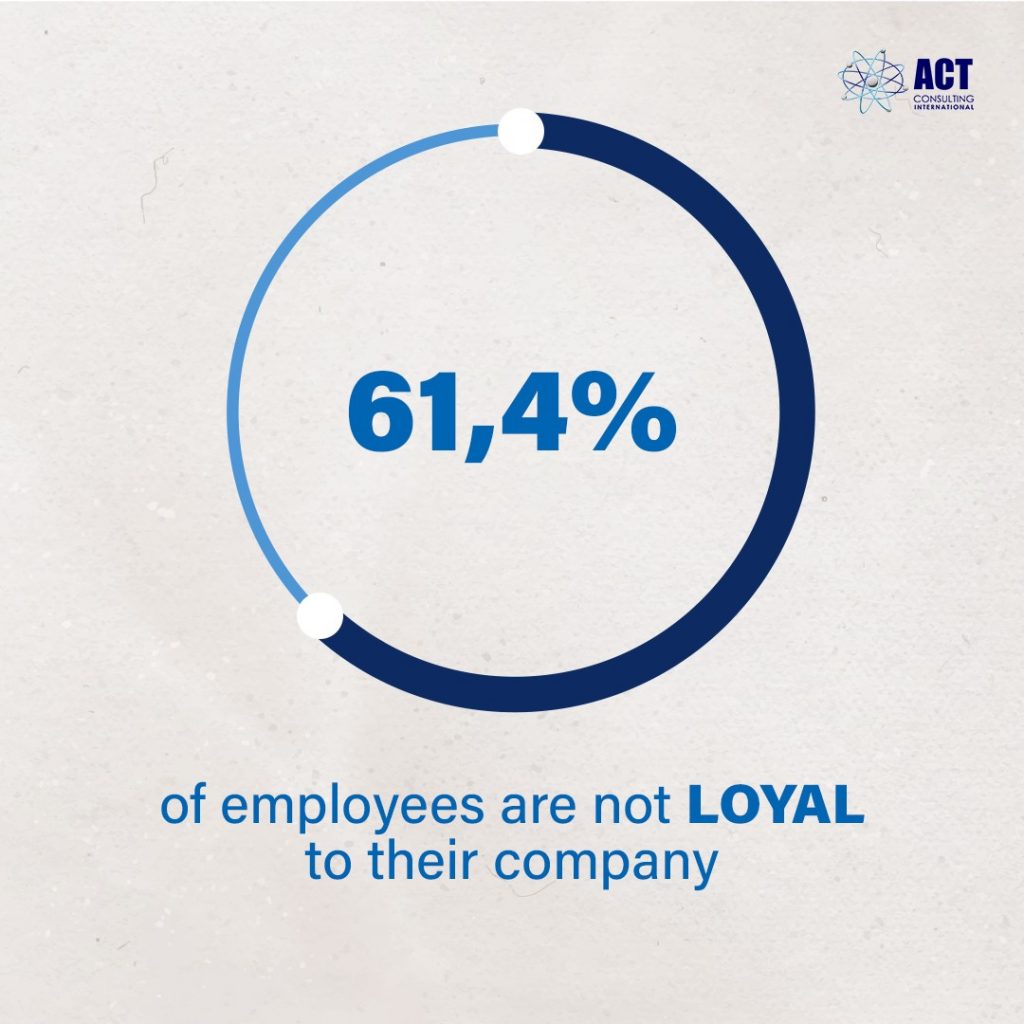
Hiring good people is tough, but as every senior executive knows, keeping them can be even tougher. Based on ACT Consulting’s ACHI (AKHLAK Culture Health Index) data, it’s revealed that only an average of 38,6% of employees are loyal to their company. This means that more than half of a company’s employees are disloyal.
Our research also suggests that quite another dynamic is frequently at work. Many talented professionals quit their organizations because senior managers don’t grasp the psychology of work satisfaction; they presume that people who excel at their work are fundamentally happy with their jobs. Sounds logical enough. But the truth is, great skills don’t always follow job satisfaction. Many professionals, particularly the leagues of 20- and 30-somethings streaming out of today’s master’s programs, are so well educated and achievement-oriented that they could succeed in virtually any job. But will they stay? What can companies do to address employees’ dissatisfaction and prevent rapid turnover?
The answer is: only if the job matches their deeply embedded life interests and they are given a space where their voices could be heard.
This idea is rooted in a popular economic theory, first proposed by Albert Hirschman in 1970 in a book titled Exit, Voice, and Loyalty, which argued that workers can do one of two things when faced with an unsatisfactory employment situation: exit the relationship (quit), or voice their concerns and try to work through their problems. Most notably, finding an outlet to voice employees’ frustrations improved retention. Other employee satisfaction research compared the quitting behavior of employees in treatment and control groups, where one group would receive a wage hike and the other received a voice intervention. The research found that quitting was 20% (approximately 4 percentage points) lower in the group that received a voice intervention in the months following a wage hike. This implies that the effectiveness of the voice intervention arises from its ability to mitigate disappointment.
Leaders also play a role in retaining employee loyalty. They need to be competent at their job while also managing their employees. Be it past or present, most managers are not leaders and leaders are not managers. Still, what are the differences?
Kotter (2001) defines managers’ focus on formal directing and controlling of their assistants, resources, structures, and systems. Managers aim to reach short-term goals, avoid any risks, while also establishing a standardization to improve efficiency. Employees would follow a manager’s direction in exchange for being paid a salary, known as a transactional style.
Studies show that being a capable manager depends upon three special skill sets: technical, human, and conceptual. Technical skill refers to knowledge in a specific type of work. This may include competencies within a specialized field, or the ability to use appropriate tools and techniques. Human skill refers to 7 the ability to work with people, which allows a manager to assist group members to complete a task. Conceptual skill refers to the ability to work with ideas. Moreover, a capable manager needs to have specialized qualities like good communication, organizational, negotiation, and delegation skills.
Today, Leadership skills are needed, though usually a company or business has an idea of what makes a good employee but doesn’t know how to get an employee motivated and working within that company. Leaders are becoming younger and their interactions with actual human beings are becoming less and less. Leaders need to focus on motivation and inspiration. They need to aim and create a passion for their employees to follow their vision, reach long-term goals, take risks to accomplish common goals, and challenge the current status quo. Leaders must keep an open eye on their followers’ benefits, so people will follow them willingly and voluntarily, and leaders direct their followers by using a transformational style.
In a context where turnover is high and workers do not typically have many opportunities to communicate their concerns to management, providing workers with a voice can be a simple yet powerful way to keep workers from quitting. Leaders are ones that wrestle with the ever-changing visions of businesses; be it rapid change or slow progressive change, they make the visions of the company or corporation come to life through employees. That’s why leaders needed to understand that their role is not only to manage their employees but also to create meaning and motivation within their company. The most sustainable solution to worker dissatisfaction is creating actual change in managerial decision-making, enabling voice to have not only an intrinsic but also an instrumental role in improving workers’ employment experiences. But those changes required a commitment to transform a company’s culture.
At ACT Consulting International, we strive to be your best partner in culture transformation. With programs customized to your specific needs and requirements, ACT Consulting International provides you with a precise, quantifiable, and focused approach to transforming your corporate culture into a better leadership & people, business, and culture for your company.
Source:
- Adhvaryu, A., et al. 2019. Want Fewer Employees to Quit? Listen to Them. Retrieved from https://hbr.org/2019/04/want-fewer-employees-to-quit-listen-to-them
- Butler, T. & Waldroop, J. 1999. Job Sculpting: The Art of Retaining Your Best People. Retrieved from https://hbr.org/1999/09/job-sculpting-the-art-of-retaining-your-best-people
- Horn, L. 2017. Keeping Employees Loyal and Content in the 21st Century. Integrated Studies (81), 1-52. Retrieved fromhttps://core.ac.uk/download/pdf/143838409.pdf
